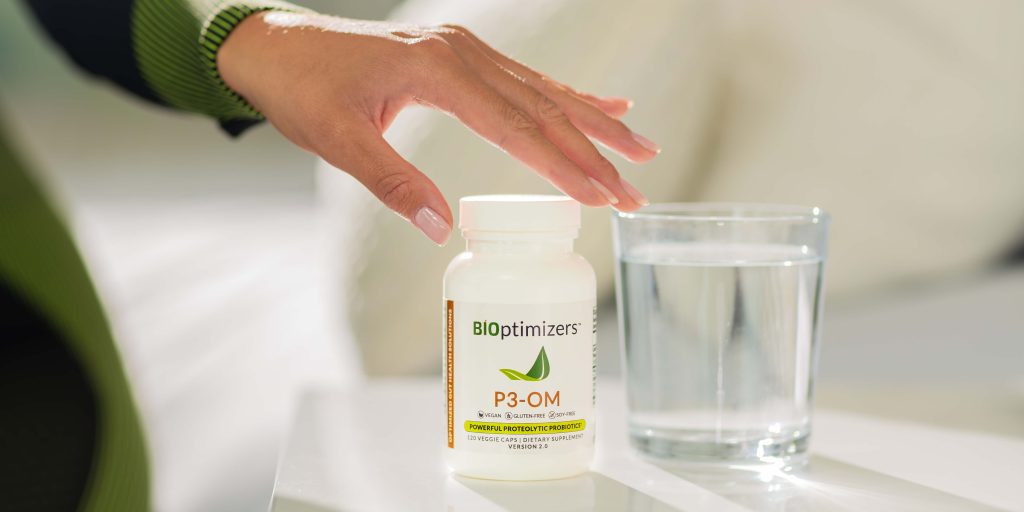Dairy vs non-Dairy Milk Alternatives: Options, Pros, and Cons

In today's dietary landscape, the choice between dairy and non-dairy milk alternatives is increasingly more important.
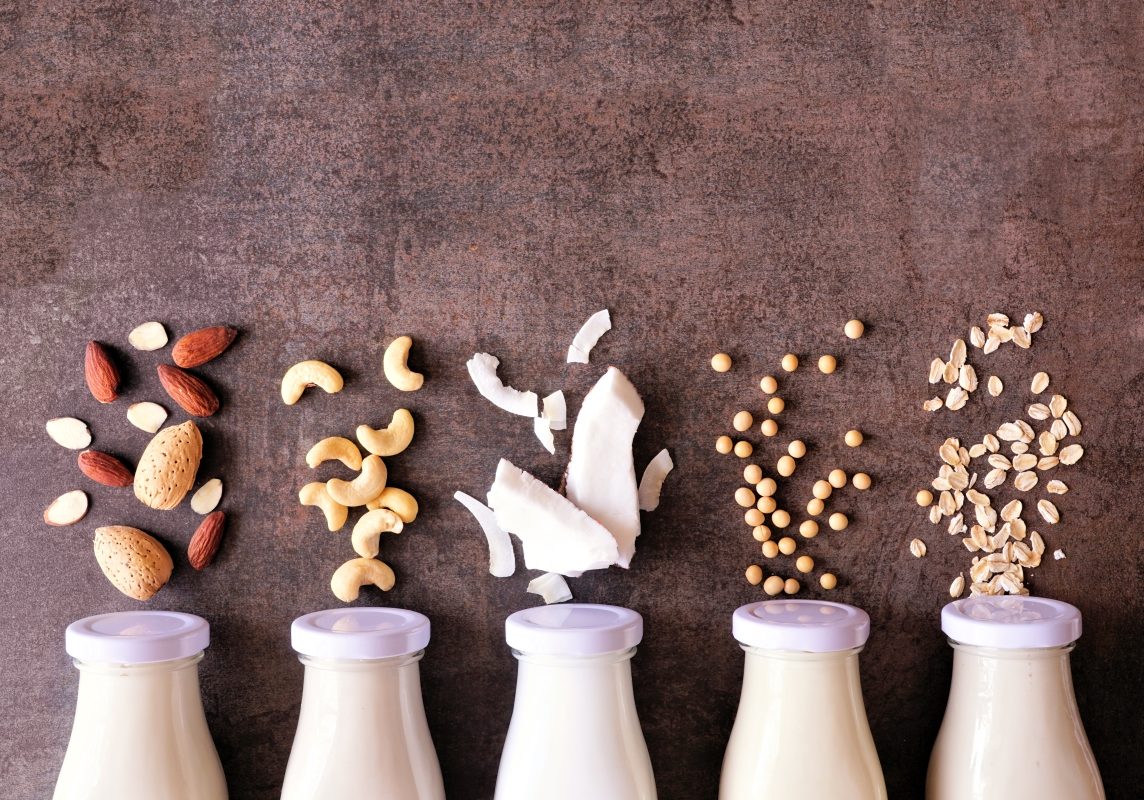
Some individuals are unaffected by dairy, while others experience discomfort due to allergies or sensitivities. Additionally, many people are shifting towards plant-based diets for environmental reasons.
Regardless of the reason, the options for milk alternatives have multiplied, making the decision on how to replace dairy more complex. This article explores the diverse world of dairy and non-dairy milk. We’ll delve into the pros and cons of each option to help you make informed choices that align with your values and preferences.
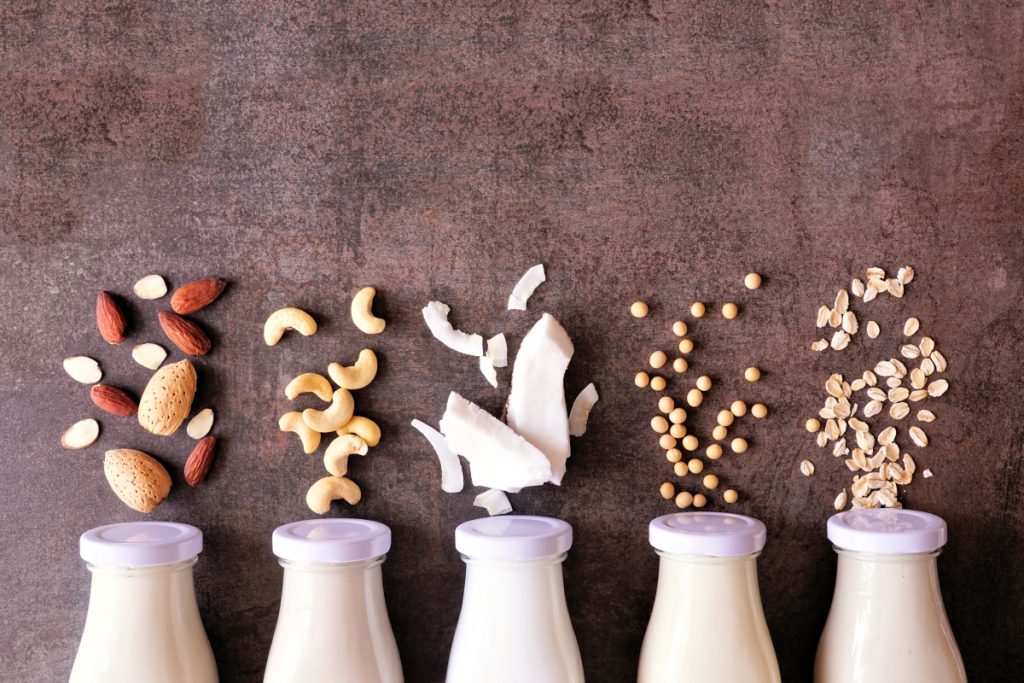
The Problem with Dairy Milk – Pros & Cons
Humans began drinking milk over 6,000 years ago. Cow’s milk is a widely consumed and nutritious food that provides essential nutrients for human growth and development. It contains high-quality protein, and some studies suggest it may protect against some chronic diseases with minimal adverse effects.
Cow milk is rich in macrominerals and vitamins. Based on adequate intake by a healthy person, an adult male, consuming 100 ml of cow’s milk provides:
- 16.2% calcium
- 3.2% magnesium
- 2.9% sodium
- 4.1% potassium
- 15.4% phosphorus
- 15.5% vitamin A
- 3.8% vitamin D
At the heart of the trouble with milk is its main protein: casein. The most common types of this protein are A1 and A2. A1 milk, found in cows of northern European origin, differs due to an amino acid variation affecting casein digestion. Research suggests A1 milk may trigger immune responses linked to:
- Allergies
- Eczema
- Asthma
- Diabetes
- Autism
- Digestive problems
- Mental health issues (according to animal studies, which may or may not apply to humans)
It could also cause gut inflammation and lead to leaky gut.
A2 milk, on the other hand, coming from cows from southern France and the Channel Islands, doesn’t tend to cause the same inflammatory response or immune reactivity.
For some people, transitioning to A2 milk may support digestive health and reduce inflammation. However, others could have dairy allergies or sensitivity to both types of milk. For a detailed exploration of A1 and A2 milk differences and potential health effects, check out this article.
Understanding different milk varieties can empower your dietary choices. Let’s dig into other possibilities.

Dairy Milk From Other Animals
Beyond cow milk, there are other animal varieties available, including:
- Goat
- Sheep
- Water buffalo
- Camel
These types tend to be primarily A2 milk, which is less inflammatory; however, some people still experience reactions to them. Let’s take a look at some of their unique health properties.
Goat
Goat milk’s nutritional values vary based on breed and season. Anecdotal evidence suggests many benefits like improved:
- Absorption of iron and copper
- Growth rates
- Bone density
- Blood levels of vitamins and minerals, vitamin A, Calcium, thiamine, riboflavin, and niacin
Goat milk has nutritional advantages over cow milk because it has less fatty acids and a better sodium-potassium ratio. It also contains:
- Lower concentrations of individual saturated fatty acids associated with increased risk of cardiovascular diseases
- A better fatty acid profile, including overall polyunsaturated fatty acids (a combination of omega-3s and omega-6s), eicosapentaenoic acid (EPA), and docosahexaenoic acid (DHA)
- Isoflavones
- Minerals such as boron, copper, magnesium, manganese, phosphorus, and iodine
On the downside, goat milk still contains lactose, which may pose a problem for those who are lactose intolerant. Compared to cow milk, it also has lower concentrations of:
- Omega-3 fatty acids – Although rich in polyunsaturated fats, it may not be as effective in delivering the specific omega-3 fatty acids known for their health benefits.
- Vitamin A
- Minerals sulfur, calcium, and zinc, which play a significant role in your body
Sheep
Sheep milk could be an alternate source of dairy. While they both contain lactose, they differ in fat and protein content, making digesting sheep milk easier.
A study of 30 women avoiding dairy explored the effects of sheep milk on digestive symptoms. They drank 650 ml of cow or sheep milk on two separate occasions one week apart. After drinking sheep’s milk, hydrogen levels were lower, suggesting a milder digestive response.
Beyond being gentler in digestion, sheep milk has some exciting nutritional aspects. It is a rich source of bioactive substances, including high levels of:
- Fatty acids
- Immunoglobulins
- Protein
- B vitamins and minerals
- High linoleic acid content: supports a healthy heart and healthy inflammatory response
- Biopeptides: have antiviral and antibacterial properties and promote a healthy inflammatory response

Water Buffalo
Water buffalo milk may be best known for its use to make mozzarella. It’s now becoming more popular as a cow milk alternative. However, it does have higher amounts of lactose than both cow and goat milk.
| Type of Milk | % of Lactose |
| Goat | 4.16 |
| Cow | 4.76 |
| Buffalo | 4.86 |
Compared to cow and goat milk, buffalo milk has higher amounts of:
- Fat which can aid vitamin and mineral absorption
- Protein
- Minerals, including calcium, magnesium, and phosphorous
We need more research to fully understand water buffalo milk’s health benefits, but buffalo milk may have probiotics that support a healthy gut.
While all of these animal milk varieties are rich sources of nutrients, they may still not be a good option if you’re looking for lower fat or lactose. To look for additional options, we’ll turn to plant-based alternatives.
Non-dairy Milk (mylk) Options Comparison
Many people choose plant-based milk if they can’t have dairy for health or ethical reasons. It’s easy to get confused with the pros and cons because there are now many types of plant-based milk to choose from. This makes it more challenging to find the one that suits your dietary needs.
In this section, we’ll look at some important factors to consider and then look more closely at each milk option.
Overall Considerations
Preparation
The production process for most milk alternatives typically follows a consistent method. It begins with soaking the primary ingredient, like nuts, in water for an extended period, usually several hours. After soaking, the ingredients are blended into a creamy puree. This puree is filtered to separate the milk from the plant material and finally boiled.
You can prepare plant-based milk at home, or you can buy it commercially prepared. Be aware, however, that commercially prepared varieties often come with added emulsifiers or texturizers that can irritate your gut.
A study of nine healthy adults explored the effects of emulsifiers on the gut microbiome. Participants ate either an emulsifier-free diet or an identical diet enriched with 15g daily for seven days. Those who ate the emulsifier-enriched diet experienced:
- Increased abdominal discomfort after eating
- Reduced gut bacteria diversity
- Lower fatty and amino acid levels
- Signs of inflammation in their gut’s mucus layer
The levels of emulsifier consumed in this study are similar to what someone eating processed food would have. It is still a concern to remember.
The plant-based milks that are higher in unsaturated fat, such as nut mylks, could turn rancid easily as the preparation exposes the fats to air. So, if you make it at home, be sure to discard leftovers once they turn rancid.

Antinutrients
It’s also important to know that consuming plant-based milk alternatives increases your exposure to antinutrients. This isn’t necessarily a bad thing.
Antinutrients, such as lectins, phytates, and tannins, can potentially disrupt your body’s absorption of essential minerals like calcium, magnesium, iron, and zinc. Lectins, in particular, can lead to gut issues, including intestinal permeability and leaky gut, especially if you’re sensitive to them.
Antinutrients also have health benefits. They act as antioxidants and anticancer agents. They also aid digestion and help maintain blood sugar levels. Phytates contribute to lowering cholesterol, and tannins may have antiviral, antibacterial, and antiparasitic effects. However, soaking the nuts and beans can eliminate a lot of these antinutrients.
Effects on Blood Sugar
Another overall concern when it comes to plant-based options is their ability to spike your blood sugar. Some do this more than others.
While cow’s milk and non-dairy milk all have sugar, they don’t have the same kind. Cow’s milk has lactose, and plant-based drinks have:
- Glucose
- Sucrose
- Maltose
- Fructose
Except for fructose, all these sugars have a higher glycemic index value than lactose. This matters because it can change your glycemic response and increase your blood sugar levels after consuming them. It’s important because it can lead to trouble with blood sugar control and insulin levels.
While all non-dairy milk varieties have a higher glycemic response than cow milk, the highest are rice and oat milks. These non-dairy milks are also processed foods where the carbohydrates are removed from their fibrous shells. In addition, the sugar-sweetened type may taste more neutral but affect your blood sugar more strongly.
Nutrition
Compared to dairy milk, switching to plant-based milk, especially if homemade and not fortified, could result in lower intakes of:
- Protein
- Phosphorous
- Choline
- Vitamin B12
- Calcium
On the other hand, pre-packaged non-dairy milk tends to have higher vitamin and mineral levels than dairy milk due to fortification.
Now that we’ve covered some overall considerations, let’s dig into each plant-based option individually.
Soy
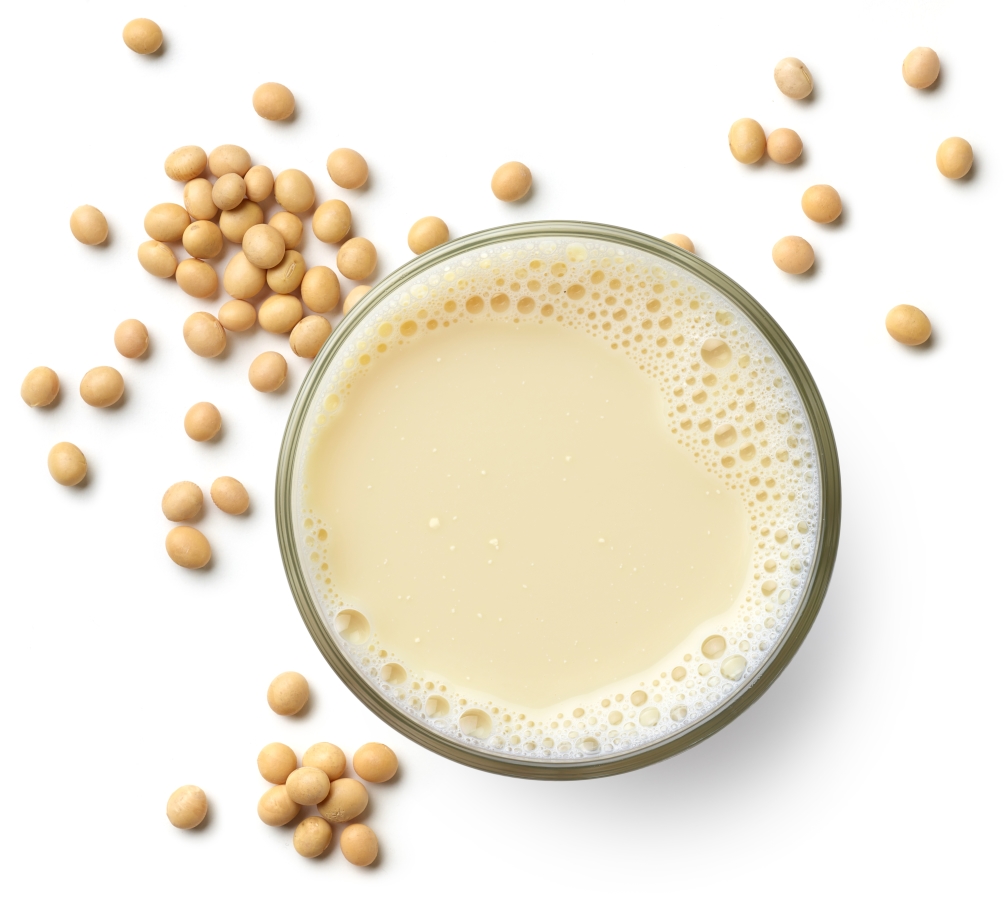
You may think of soy milk as one of the first milk alternatives on the market. It was the most popular for a long time before others came onto the market. It is made from either soybeans or soy protein and is rich in fat and protein.
One cup (240 ml) of soy milk contains:
Calories: 95
Protein: 8 grams
Fat: 4.5 grams
Sugar: 3 grams
Total carbohydrates: 5 grams
Vitamins and minerals: Soy milk is higher in vitamins B1, B2, and B6; folic acid; and vitamins E and K1 than other alternatives. It also provides significant amounts of all minerals except sodium, iodine, and chloride.
Anything soy-based, however, comes with controversy. One possible concern with soy milk is that it naturally contains phytoestrogens and goitrogens that can act as a hormone disruptor. They are also high in omega-6 fatty acids, which may be pro-inflammatory or detrimental to your heart health.
Another downside of soy is the risk of allergy. It is one of eight foods that can cause immediate allergic reactions. You’ll want to stay clear if soy allergy is a concern for you.
Almond
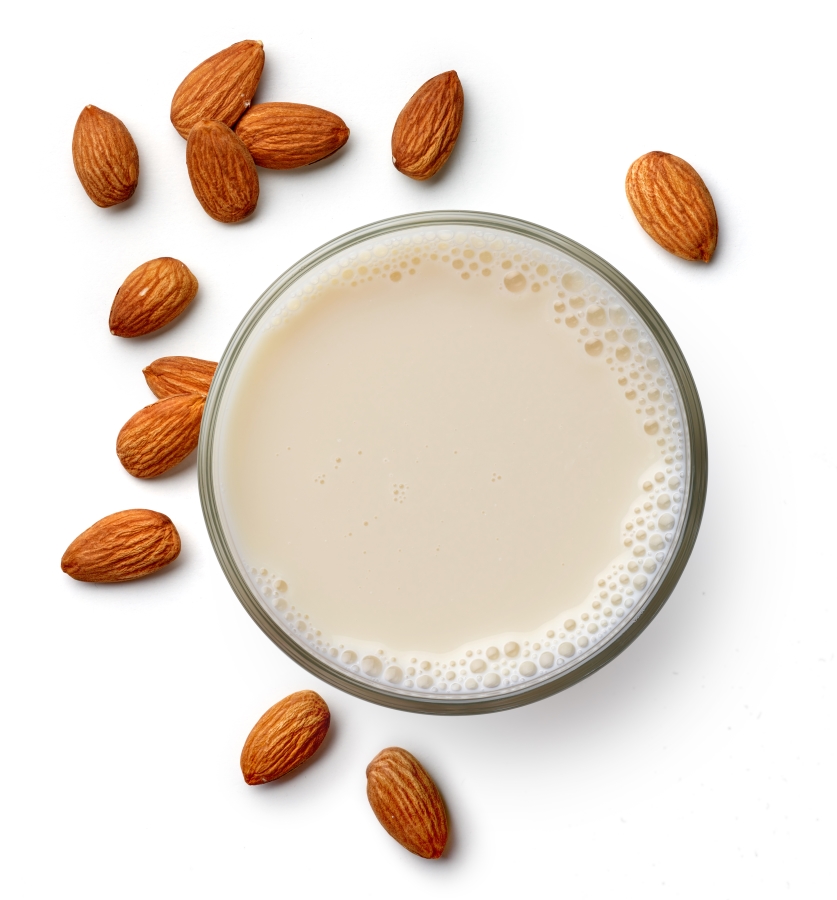
Almond milk has a mild, slightly nutty flavor and a creamy texture. It’s versatile, but avoid it if you have a nut allergy. While almonds are naturally high in protein, once strained, it’s left out of the final product.
One cup (240 ml) of almond milk contains:
Calories: 35
Protein: 1 gram
Fat: 2.5 grams
Sugar: 0 grams
Total carbohydrates: 1 gram
Vitamin and mineral highlight: Almond milk is a rich source of vitamin E, a fat-soluble vitamin crucial in safeguarding your cells against damage caused by free radicals.
Overall, almond milk is a great option for those looking for a low-calorie milk substitute, but add extra protein to your diet because you won’t find it here.
Cashew
Cashew is very similar to almond milk but much creamier due to its higher fat content.
One cup (240 ml) of cashew milk contains:
Calories: 79
Protein: 2 grams
Fat: 6 grams
Sugar: 7 grams
Total carbohydrates: 9 grams
Vitamins and minerals: Just like almond milk, cashew milk boasts a naturally high vitamin E content.
While cashew is a great low-carb, low-calorie option, it’s also low in protein when commercially prepared, and you’ll have to make sure to make up for it in other ways.
Unlike almonds, it’s not necessary to strain cashew milk during preparation. If you’re making it at home, you can instantly increase the nutritional profile by blending well. This will allow you to hold on to more protein.
Macadamia
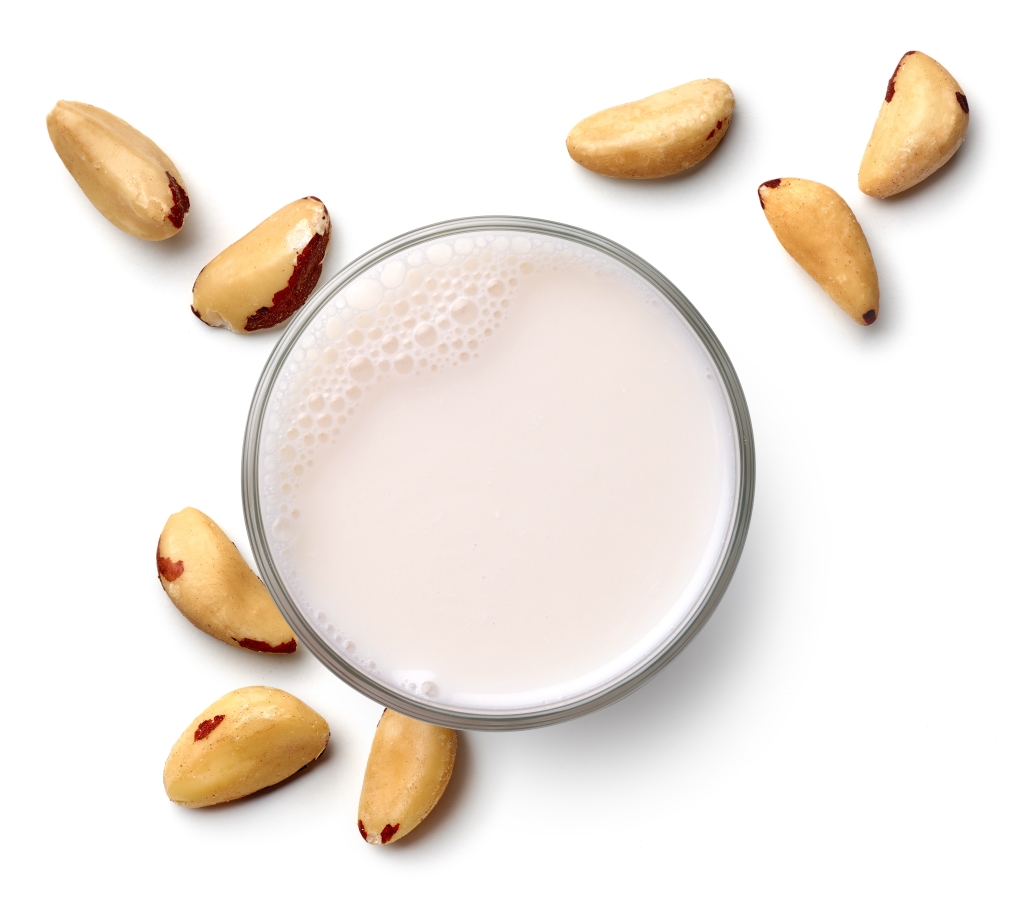
While often blended with other nut milk, macadamia milk is slowly becoming more popular as a solo option because it’s higher in monounsaturated fats than other nuts.
When prepared without straining at home, you can double the amount of protein compared to cashew milk. However, pure macadamia nut milks are more expensive than other nut milks because macadamias are more expensive.
One cup (240 ml) of macadamia milk contains:
Calories: 50
Protein: 1 gram
Fat: 5 grams
Sugar: 0 grams
Total carbohydrates: 1 gram
Vitamins and mineral highlights: Macadamia nuts are naturally high in vitamins B1 and B6 and minerals like manganese, iron, and magnesium.
Macadamia nuts are a rich source of monounsaturated fatty acids. A study of 25 subjects explored the effects of eating macadamia nuts on cholesterol and heart health. Participants followed either a typical American diet or a diet including 1.5 ounces of macadamia nuts daily for five weeks.
Those eating a diet rich in macadamia nuts had lower total cholesterol and LDL cholesterol than the typical American diet. They also had improved LDL to HDL ratios associated with improved heart health.
Coconut
Made from the white meat of brown coconut, coconut milk is naturally fatty. This gives it a full, creamy texture that can feel more like cow milk than other alternatives that can be a bit watery.
One cup (240 ml) of coconut milk contains:
Calories: 45
Protein: 0 grams
Fat: 4 grams
Sugar: 1 gram
Total carbohydrates: 1 gram
Vitamins and mineral highlights: Coconut milk is a naturally good source of potassium, with about 19 mg per cup.
One of the most significant nutritional benefits of coconut milk is the lauric acid found in coconut fats. A meta-analysis of 60 studies explored the effects of various fats on cholesterol. Lauric acid had the most significant cholesterol-raising effect among all fatty acids, but much of this effect is due to raising HDL cholesterol (the “good” kind).
So, when considering the ratio of total cholesterol to HDL cholesterol, lauric acid has a more positive impact than any other fatty acid, whether saturated or unsaturated.
Unsweetened coconut milk could be keto-friendly thanks to some short-chain fatty acids. However, watch out for sweetened options like those for cocktails that could be very high in sugar.
Rice
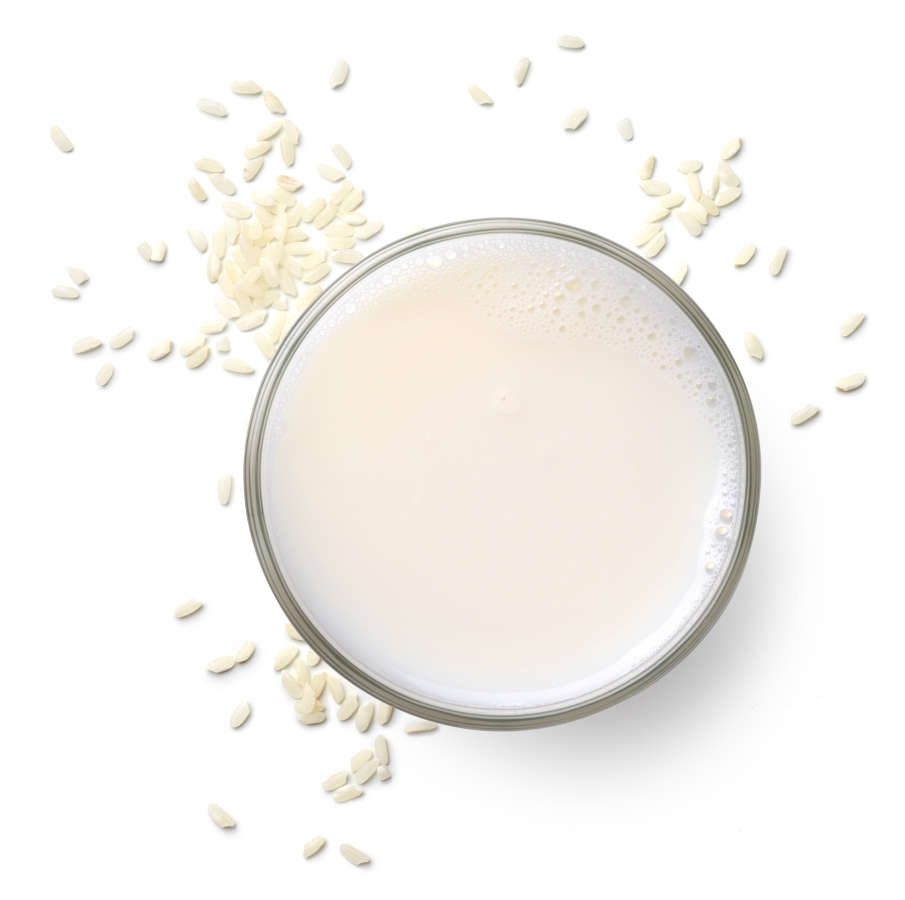
Rice milk has a naturally sweet taste. This is due to carbohydrate breakdown during processing and contains more sugar than cow’s milk, even without added sugars. Rice milk is a great option if you want to avoid lactose and worry about allergic reactions from soy and other nut milks.
One cup (240 ml) of rice milk contains:
Calories: 130
Protein: 1 gram
Fat: 2.5 grams
Sugar: 14 grams
Total carbohydrates: 26 grams
Vitamins and minerals: Rice milk tends to be highly lacking in vitamins and minerals unless fortified.
One concern with rice milk is naturally occurring arsenic levels. This is mainly because rice easily absorbs arsenic in the soil it’s grown in. A study of 28 rice milk samples found that some tested up to 70% higher than WHO safety levels.
Something else to remember if you’re considering rice milk is that it can really spike your blood sugar.
Oat
After preparation, oat milk offers a low-fat creamy milk alternative with higher fiber than others, with about 2g per cup.
One cup (240 ml) of oat milk contains:
Calories: 145
Protein: 2 grams
Fat: 1 gram
Sugar: 8 grams
Total carbohydrates: 23.5 grams
Vitamins and mineral highlights: Oat milk contains high levels of B vitamins and E. It also beats cow’s milk in iron, potassium, and phosphorous levels.
Oat milk contains β-glucan, a soluble fiber that may help lower cholesterol, blood lipids, and blood sugar. Oat milk has Avns, special oat compounds that help with inflammation and have antioxidants.
If you’re choosing to drink oat milk, buy organic. Non-organic oats are likely to contain glyphosate, a heavily used pesticide.
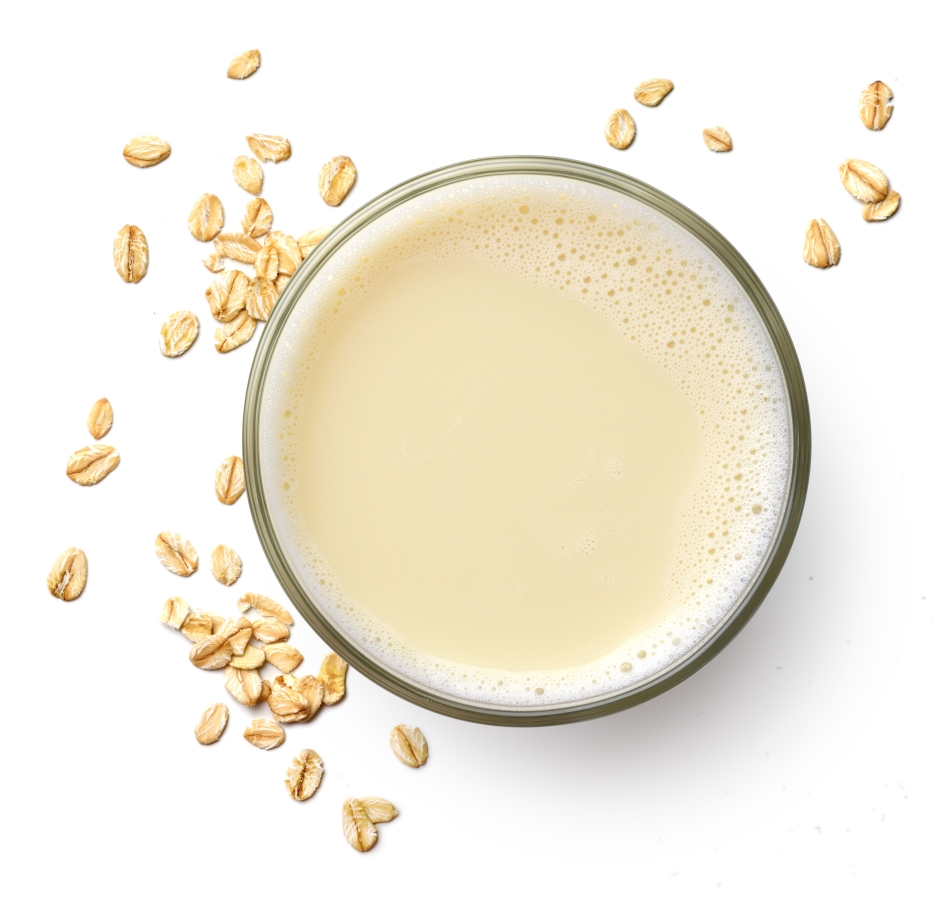
Hemp
Made from hulled hemp seeds, hemp milk could be an excellent hypoallergenic and high-protein alternative for those also avoiding nut milk. It has an earthy flavor that may take some getting used to, but it could be worth it to reap its health benefits.
One cup (240 ml) of hemp milk contains:
Calories: 45
Protein: 2 grams
Fat: 3 grams
Sugar: 1 gram
Total carbohydrates: 6 grams
Vitamins and mineral highlights: hemp-based beverage is higher in biotin and pantothenic acid than other milk alternatives . Pantothenic acid and biotin help your body break down and use food. It’s also rich in antioxidant vitamin E at 7.2mg per cup.
Along with soy milk, hemp milk is closest to cow’s milk in protein content compared to other non-dairy alternatives. It also contains all essential amino acids, making it a complete protein.
Moreover, it has a nearly perfect ratio of omega-6 to omega-3 fatty acids, 3:1. This could help decrease inflammation and support heart health. Additionally, it has a lot of gamma-linolenic fatty acid, which helps with a healthy response to inflammation and heart health.
Pea
Pea milk is one of the latest non-dairy alternatives to hit the market. It’s made from yellow field peas and is naturally high in protein. Unlike many nut milks, protein isn’t lost during commercial preparation.
One cup (240 ml) of pea milk contains:
Calories: 120
Protein: 8 grams
Fat: 4.5 grams
Sugar: 11 grams
Carbohydrates: 12 grams
Vitamins and mineral highlights: Pea milk is a good source of potassium, magnesium, and vitamins A, B, and C.
Pea milk is an excellent choice if you’re looking for an environmentally-friendly option. Field peas have a small carbon footprint and need less water to prepare than almond milk.
Non-Dairy Alternatives Run-Down
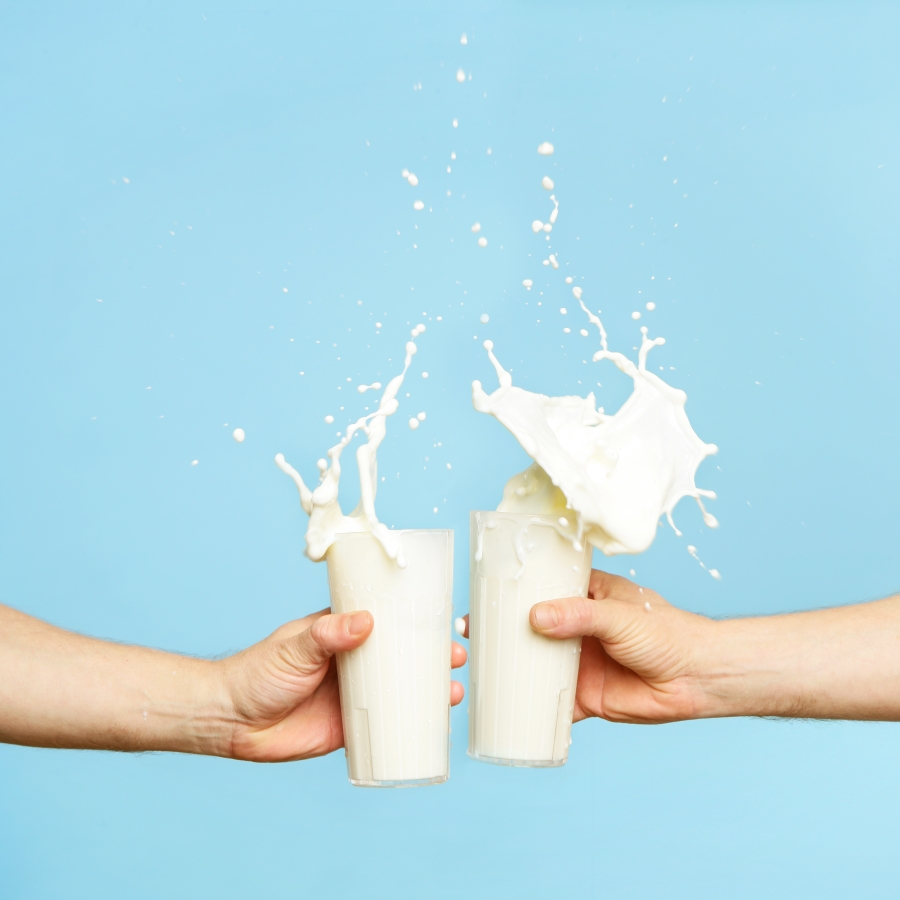
Overall, from a nutritional perspective, plant-based milk alternatives vary greatly. When fortified, they can be even richer than dairy milk. To ensure you get the most out of these fortified vitamins and minerals, shake before you pour! Otherwise, they settle at the bottom and won’t make it into your cup.
If you make plant-based milk at home, you won’t get the extra vitamins and minerals in store-bought milk. Be aware of what’s missing and make up for it through diet and other supplements.
Here are some non-dairy alternative highlights:
Highest protein: Soy and pea
Lowest calorie: Hemp, almond, and coconut
Highest glycemic impact: Rice and oat
Lowest glycemic impact: Hemp, pea, and coconut
Minimal environmental impact: Coconut, Pea, and Hemp
Most hypo-allergenic: Rice
These are only some highlights of the available options. You’ll need to make a choice that best supports your body’s needs. Overall, be aware of sweetened and flavored varieties! They can be loaded with sugar and undermine your health goals.
Conclusion
Dairy offers essential nutrients but can be problematic for some due to proteins like A1 casein. Non-dairy alternatives have expanded dramatically, but each alternative, from soy to pea, offers distinct nutritional benefits and potential drawbacks.
As you determine what milk is right for you:
- Consider your dietary goals and health factors
- Be mindful of added sugars and emulsifiers in commercial products
- Consider making non-dairy milk at home
- If you do buy commercially prepared, always shake before you pour!
- Try different varieties and go with what feels good to your body.
By exploring this diverse world of milk, you can make choices aligned with your values and preferences to support your overall well-being.





